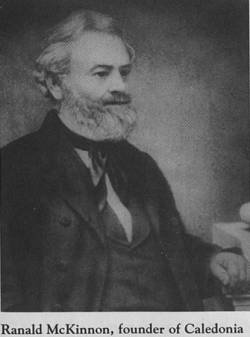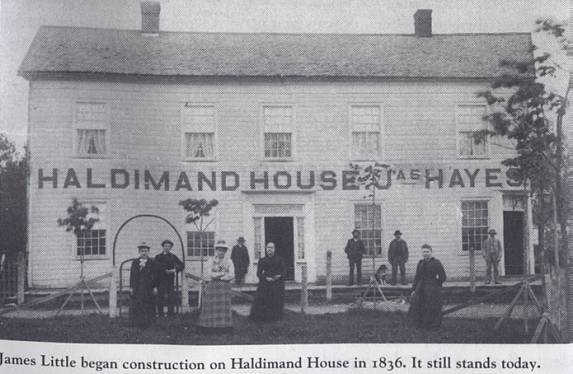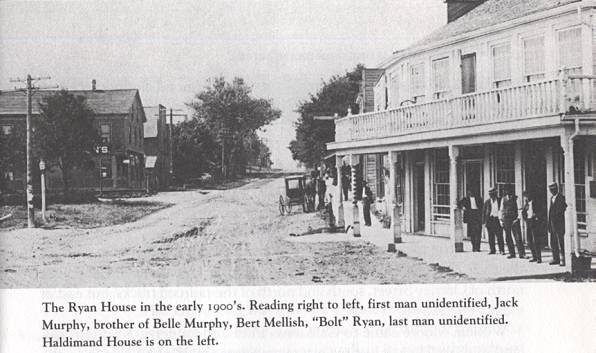|
 By
1846, just 11 years after Ranald McKinnon first arrived in this wilderness
area, Caledonia was booming. The dam was built, the river was busy
transporting goods and people, the plank road was open for traffic from
Hamilton to Port Dover, a swing bridge allowed for easy travel across the
river and streets and squares were named. By
1846, just 11 years after Ranald McKinnon first arrived in this wilderness
area, Caledonia was booming. The dam was built, the river was busy
transporting goods and people, the plank road was open for traffic from
Hamilton to Port Dover, a swing bridge allowed for easy travel across the
river and streets and squares were named.
What had been Seneca Village to the
east and Oneida Village to the west on the north side of the river were
now part of the village of Caledonia. The other nearby small residential
areas of Sunnyside and South Seneca Village were not yet included. For
some time the village of Oneida was nicknamed Little Caledonia, while the
village of Seneca retained its original name for specific referral.
What in 1835 had been no more than
Mr. Bryant’s tavern on the north east corner with the two adjacent log
houses, by 1846 consisted of a physician’s residence, five stores, three
taverns, two grocery stores, two wagon-makers, two cabinet-makers, three
blacksmiths, three shoemakers, three tailors and two bakers. Ranald
McKinnon’s saw and grist mills and Jacob Turner’s saw mill would, in 1850,
be joined by McKinnon’s woollen mill. Some three hundred people were
residing and working in Caledonia with more arriving each day.
Born in Ardelum on the Isle of Mull,
Argyleshire, Scotland on September 11, 1801, Ranald McKinnon was just four
years old when his family emigrated to Masonville, New York. In 1820 the
family moved to Esquising, not far from Streetsville in Canada. At age
twenty-four Ranald was employed in building the Rideau Canal. By the time
he left in 1832 he had established a reputation of achievement in the
construction field. In 1835 he was commissioned as a contractor on dam and
lock number five for the Grand River Navigation Company. It was McKinnon
who pushed to have the bridge built in the location it now stands, a
legacy to his foresight. Otherwise the bridge might have been built at the
Seneca Village area.
McKinnon’s ability to remain in the
public eye was rewarded once again when he was contracted, in
1845, to build the
portion of the plank road from Hagersville to Port Dover, thus completing
the earlier link from Hamilton Mountain to Hagersville. By this time
McKinnon’s efforts and acquisitions were increasing his wealth. It was
McKinnon who had land or housing to either sell or rent to the Mill
workers needing housing for their families. He had positioned himself
well.
It is not surprising that McKinnon
was also becoming interested in politics. About 1846 he was petitioned to
run for political office by residents of the community who felt they
needed a local representative familiar with the needs of the area. The
tradition of someone from Toronto whose main interest was to "act" in
parliament was losing favour. In 1851 he ran for the Haldimand seat
against William Lyon McKenzie and George Brown. This was a hard-fought
by-election held to fill the vacancy left by David Thompson’s death.
Despite the local petitions McKinnon lost by a few votes to William Lyon
MacKenzie of Toronto. [Mackenzie, 462;
McKinnon (Conservative), 399; Brown, 283; and Case, 113. – Examiner,
April 16th, 1851.]
There were four general elections
from 1851 to 1858. In the first three, McKinnon ran for the Conservative
party and lost to the "Little Mac". In his fourth and last effort in 1858,
MacKinnon dropped out at the last minute, perhaps avoiding what might have
been another defeat.
During the 1870’s the once wealthy
mill owner was having severe financial problems. Many properties he owned
had to be sold under the Insolvent Act. His grist and woollen mills had
burned down in the fifties and again in the sixties. The rebuilding had
required considerable expense. However, by 1873 McKinnon found his place
in local politics. He was back as Reeve and was still the optimist despite
his earlier setbacks.
In 1875 he initiated the
construction of a steel bridge on the original site to replace the initial
wooden structure. That structure would remain until 1927 when the present
bridge was built.
By the time Ranald McKinnon died in
1879, a handsome village and community had evolved from an area that had
been dense with bush and wilderness only forty-four years earlier. His
vision and efforts against numerous odds led to his being known as the
"Incurable Optimist" and the founder of Caledonia.
The McKinnon Lifestyle
The Ranald McKinnon home still
stands today at 232 Caithness St. West, overlooking the dam. For almost a
century it remained in the family, but once sold it gradually fell into
relative obscurity, its historical significance all but forgotten.
Ranald, 34 years old when he came to
work on the dam in 1835, was married in March of that same year to his
cousin, Euphemia McKinnon from Masonville, New York. Euphemia was just 22
years old at the time.
The McKinnons had nine children.
Malcolm, Donald, Mary and Catherine died shortly after birth. Christina,
Isobella, Flora, Archibald and John survived and the McKinnon household
prospered. Soon Ranald was known as Squire McKinnon to separate him from
other McKinnons living nearby. Besides his sons there were Neil, a nephew
and Dr. Ranald, a son of Neil.
Stories passed down by persons who
knew the family and who visited in the home in their youth describe the
McKinnon family as living in a gracious manner. As they became more
prosperous the original log home was torn down and a large new home with
an east and west wing was built on the same property. The east wing
contained the drawing room while the west wing, with a separate entrance,
was Ranald’s office. Above his office were the servants’ quarters. To the
rear of the west wing, there was a coach house with room for two coaches.
Later this would become the garage. The main house, without the wings, had
fourteen rooms.
In 1842 Ranald McKinnon was
identified as a merchant engaged in trade and commerce as well as owner of
the sawmill. He had a store at the northwest corner of Argyle and
Caithness St. listed under the name of his good friend John Scott & Co.,
to keep it separate from his mills. He owned 40 acres described as
occupied and 70 acres listed as improved. Records show that in one year he
produced 40 bushels of wheat and 150 bushels of potatoes and that he had 7
cattle, 3 horses, 8 sheep, 7 hogs and 20 pounds of wool. He also had three
servants.
The McKinnons, active Presbyterians,
supported the building of the first Presbyterian Church in 1849. Their
Sabbath School Picnic of 1859
was held at Squire McKinnon’s grove on his farm.
He had placed tables, benches and swings on the grounds to accommodate
about 80 children plus a large number of adults. It is likely that there
were many such events held at his home.
When he ran in his last campaign in
1858, the publisher of the Grand River Sachem, known to be a
Conservative newspaper, said, "Mr. McKinnon is not only well known
throughout the county but possesses a name in every part of Upper Canada
as an extensive manufacturer and merchant, a gentleman of more than
ordinary abilities as a practical business man, and just such a one is
required at this time to study and carry out the wishes of an agricultural
and manufacturing community such as ours."
By 1861, the Ranald McKinnon
household included four carriages for pleasure, with an acre of land
attached to the house. His business, still expanding, consisted of
merchandising, milling, farming and lumbering. He annually employed an
average of twenty-five men and two women.
The properties just east of the home
at 194-196 Caithness Street and at 192 Caithness Street West were also
owned by Ranald McKinnon. Both these homes still stand. The one at 192
Caithness was built in 1860 for his eldest son, John, who later sold it to
his brother Archibald for $2,000. John had acquired it from his father for
$1,700.
John and his wife Sophia (Matthews),
an accomplished musician, played a major role in the life of Caledonia.
John, who owned a dry goods store in the village, became the Reeve on
three different occasions. Little is known of Archibald other than he
attended military school.
In 1871, just eight years before
Ranald’s death, the saw mill was worth $1,000 while his woollen factory
had a fixed capital of $31,000 and the grist and flouring mill had a fixed
capital of $9,000.
Ranald died on October 18, 1879 in his seventy-ninth
year. His wife, Euphemia, was to live for another sixteen years. She died
April 30, 1895 in her eighty-third year.
After her mother died, Christina
lived in part of the big house until she married Laughlan McQuarrie in May
of 1906. A local beekeeper, Henry Pedlow who lived in one room of the
house until 1921, said it still contained the tapestries and furnishings
that belonged to the McKinnon’s. Included in these furnishings were a
grand piano and a set of chairs.
A granddaughter, Effie Eadie,
daughter of Flora (McKinnon) Eadie of Allanhurst, New Jersey, sold the
property in 1926 to Walter Carpenter who owned it until 1940. During the
hurricane in 1936 the roof blew off the house showing rafters, of four by
four pine and the square-cut nails.
Although the dam he built has been
replaced since it was first constructed, the McKinnon home has withstood
all test of time. Today it no longer commands the attention it once did
when it was known as the Squire McKinnon’s estate home on the hill. Yet
through the careful maintenance of its former and present owners, the home
remains as an enduring remembrance of Caledonia’s founder.
James Little
It is said by some that James Little
was as much a founder of Caledonia as was Ranald McKinnon. Little’s
development of the south side of the river is reason enough for the
statement.
At the same time that Caledonia was
getting its start, so was the village of Seneca. With a year’s head start
on Caledonia, it claimed about 250 residents. Some predicted it would be
the main residential area rather than Caledonia. In
1837 further
development seemed likely when The Grand River Navigation Company obtained
a grant of 368.7 acres at Seneca Hill.
However, by 1846 Seneca was a
village with only 140 residents, a saw mill on both banks, a grist mill, a
wool carding mill, a sash and door factory, a Methodist church, a log
schoolhouse, a chair factory and a physician. The population declined as
residents were moving to the Caledonia village.
Among those businesses in Seneca was
a store run by James Little, the first postmaster of the village. Although
he was still in business in 1846 in Seneca, he had purchased considerable
land on the south side of the river in anticipation of a bridge and plank
road that would extend south to link with Caledonia.

Little’s first and oldest existing
building is the historic landmark Haldimand House. Completed in 1842, the
building’s history began in 1836 when Haldimand County issued License No.
1 for a stage coach inn. In 1867, the James Little Estate sold it to the
Sutherland family who owned it for four years and then sold to Bridget
Britton. James Hayes purchased Haldimand House in 1875. Then, in 1900 it
passed into the possession of the Matthew Richardson family estate. Today
Haldimand House is an apartment complex. Owner Louis Leousis, and his son
Chris, have plans to restore the building in an attempt to recapture some
its early grandeur when it was an inn famous for its ciders.
The plank road envisioned by James
Little is now Highway 6. Completed in
1844, it runs from Port Dover to the top of
Hamilton Mountain. With its construction completed, Caledonia forged ahead
of Seneca Village and Little’s Post Office and store were moved to the
south side.
Another landmark building, built by
James Little in the early 1850’s and which still stands today, is the
Caledonia Mill. It was first known as the Balmoral Mill, later as the
Grand River Mills and eventually became The Caledonia Milling Company.
James Little went on to construct
more homes on land he owned. One of those was the first brick home of the
area, built in 1855 at 20 Wigton Street. He also erected a hotel across
the street from Haldimand House, at the southwest corner of the bridge. In
1870, this property was sold to William Munro and later to John Ryan when
it became known as the popular Ryan Hotel or Mansion House. Today it is
owned by Mary Mellish.

An ambitious entrepreneur and an
influential contractor, James Little used his position to ensure that the
Hamilton and Port Dover Railway would run through Caledonia rather than
Cayuga. As a director of the railway line and holder of stock valued at
100 pounds, his influence led to the town’s making a 10,000 pound
(equivalent to about forty thousand dollars) commitment to the line. That
railway was not completed until 1873,
at great expense of the local populace.
Originally from Londonderry,
Northern Ireland, James Little and his wife Ann had seven children. The
eldest, John, was born in 1832. Besides John, there were William, Charles,
Leonard, Margaret Jane, Harriet and James. Margaret Jane married the Hon.
Edmond Spring Rice and lived in Montreal. William went on to become
President of the Canadian Forestry Association.
In 1867 Little’s holdings went to Thomas Cockburn Ken
of Hamilton and were later sold to Wm. Munro who also became a partner in
Balmoral Mill. James Little died in Montreal in his eightieth year,
October 2, 1883.
William Moore
If James Little was responsible for the development of
Caledonia south of the river, William Moore was responsible for the
Caledonia development north of Orkney Street, south and north of the
railroad tracks, but east of today’s Highway 6.
William Moore came to Caledonia from Londonderry,
Northern Ireland in 1840. He was just twenty-seven years old. His first
home, on the northeast corner of Highway 6 and Orkney St. E., was
constructed to resemble his family home, "Barnfoot", in Londonderry. There
he lived with his mother and sister, Elizabeth.
In 1850 William and Elizabeth bought one hundred acres
from the Crown and built numerous homes along Orkney Street, many are
still there today. One, at 96 Orkney St. E., was assembled according to a
design of a sea captain who wished a particular look-out room on the roof.
The farm home just north of the railroad tracks, now
owned by Bob and Helen Thompson, was also built by William Moore. In 1852
he sold the right of way for the railway to cut through this property. He
also owned and developed a farm on a piece of land west of Caledonia,
formerly known as the Williamson farm.
A Number 1 Lucerne seed imported from Scotland in 1881
that yielded one bushel per acre in its first year became known as Moore’s
seed, and is still grown on the farm by Bob Thompson.
Although a lifelong bachelor, William Moore was an
active community member. Along with Ranald McKinnon he helped found the
Presbyterian Church and became its first treasurer. Upon his death in 1868
he left the estate to his nephew, William Henry Moore. This nephew was
killed in the first year of his marriage leaving his widow, the daughter
of William Marston, a Caledonia storekeeper, and their infant son named
William Henry Marston Moore. The estate was administered until William
came of age. William Henry Marston Moore received the deed for the
property in 1912. He sold it in 1914. |

